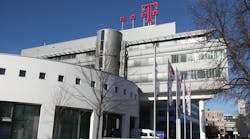Qualcomm Tests LTE over Unlicensed Spectrum in Germany
Confronting a shortage of licensed spectrum, wireless carriers are experimenting with new methods for unloading cellular data into the unlicensed spectrum. Qualcomm and Deutsche Telekom, one of the largest wireless companies in Germany, recently completed the first “over-the-air” tests of one such technology, known as Licensed Assisted Access (LAA).
Also known as LTE-Unlicensed (LTE-U), this technology helps wireless companies supplement their LTE networks by draining congestion into the unlicensed spectrum. LAA is used almost exclusively with small cells, where licensed signals preserve the necessary signaling and scheduling required for a reliable connection. Many early trails have targeted the unlicensed 5 GHz band, which is shared by the latest version of Wi-Fi.
The tests were conducted over a test network installed on Qualcomm’s campus in Nuremberg, Germany. Qualcomm designed new test equipment to monitor handoffs between the licensed spectrum, provided by Deutsche Telekom, and the unlicensed 5 GHz spectrum. Unloading data into the Wi-Fi spectrum, the network demonstrated wider coverage and greater capacity than LTE alone, the companies said in a statement. The network also made seamless handoffs between different spectrum bands.
Qualcomm’s tests are situated within a larger debate about flooding the unlicensed spectrum with overflow from licensed bands. Many companies are concerned that dipping into 5 GHz spectrum will interfere with Wi-Fi services on the same channels. The debate is playing out between telecommunications and cable companies, Internet and technology companies, and Wi-Fi equipment vendors.
In a statement about the tests, Qualcomm claims repeatedly that LAA shared the unlicensed spectrum with Wi-Fi without any adverse effects. The company says that the network demonstrated “smooth and opportunistic aggregation of unlicensed spectrum.” Qualcomm also says there was “fair spectrum usage” throughout the trial.
Qualcomm adds that their test equipment was designed to ensure that the network meets “listen-before-talk” and clear channel assessment standards. These protocols, which are often cited as the bare minimum for Wi-Fi coexistence, force the network to switch channels if the current one is occupied. According to Qualcomm, the equipment also complies with the next release from the Third-Generation Partnership Project (3GPP), the organization that maintains the LTE standard.
The tests were completed as both sides of the LAA debate have taken steps to standardize tests for Wi-Fi coexistence. Last year, tension flared when the Wi-Fi Alliance proposed a series of guidelines for coexistence tests. Verizon, T-Mobile, Qualcomm, Ericsson, and Alcatel-Lucent sent a letter to the Federal Communications Commission (FCC) complaining that the organization was trying to act as the “gatekeeper” for unlicensed spectrum. Since then, the FCC has become a kind of moderator for the debate. Last month, it gave Qualcomm permission to test LTE-U at two Verizon locations.
Opponents of the technology claim that LTE-U (an earlier version of the standard) was not designed to share spectrum with Wi-Fi. Cable Labs, a research organization supporting cable companies, says that LTE-U employed an on-off switch known as “duty cycling” instead of listen-before-talk. Reviewing the LTE-U specification, the group claimed that wireless carriers could simply turn on LTE-U to invade the unlicensed spectrum and push Wi-Fi out. When LTE-U was turned off, Wi-Fi could access the spectrum again. In recent tests conducted with Qualcomm, Cable Labs claims that LTE-U has still not demonstrated reliable coexistence with Wi-Fi.
However, companies that support LAA contend that this kind of unfair spectrum sharing has been scrapped in newer versions. And even Cable Labs sees "hopeful progress" in the development of LAA.
While Wi-Fi supporters are worried about interference, others are concerned about a fundamental breach in Wi-Fi’s unlicensed status, which the FCC has refused to regulate in order to promote innovation in the wireless industry. One commenter on a recent Microwaves & RF article said that the more important question is “whether or not we want to allow cell phone carrier companies to barge into spectrum that’s being used for established Wi-Fi.”
Although the debate only appears to resurface when new tests are completed, analysts have said that Wi-Fi is too widespread to be anywhere close to expiring. In the meantime, more LAA tests are scheduled this year. Cell phones using the technology could be available in the coming months.
